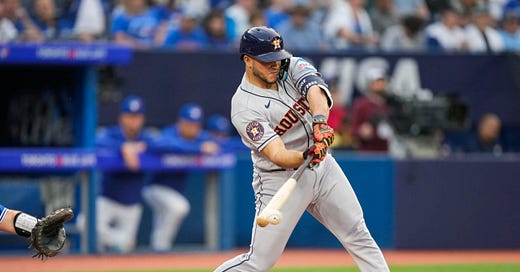The Man of Extremes—Yainer Diaz—is Playing More Often. Somewhat More Often.
Yainer Diaz has big power and a big chase rate. But he does not strike out that often, making him an effective hitter. His playing time has increased, but will it stay high in September and October?
Yainer Diaz is a man of extremes in this his rookie season in the majors. He is extreme in his power—among the best in the majors. And extreme in his willingness to swing at and chase pitches—also among the highest in the majors. He’s even extreme in his defensive metrics—near the top of the league in throwing out runners trying to steal and near the bottom in framing.
And Diaz has been extreme in the amount of discussion he has prompted among Astros fans this season. Diaz has not been an every day player for most of the season, and many have called for the Astros to increase his playing time.
I try to sort through these extremes today. I look at Diaz’s skill set—his big power and big chase rate—and his playing time. The good news is that Diaz has proven that his power and bat-to-ball skills can overcome his willingness to chase pitches out of the strike zone.
And I look at his playing time. It was in the extremes in the early part of the season, but increased when Yordan Alvarez was on the IL. Since Yordan has returned, Diaz has still received a healthy amount of playing time, though less than that of an every day player.
And that leaves open an important question with Diaz. How much will he play down the stretch as the team tries to win the AL West and clinch a playoff spot. And how much will he play in October.
Big Power, A Quick Bat, and No Walks
What type of hitter is Diaz? He' is a man of extremes at the plate.
You can see a lot of that by looking at the “lollipops” on his Baseball Savant page. One notices a lot of red, which is good. But it is worth noting that several of the Statcast metrics are all focused on the same thing—power. And Diaz has a lot of power.
He is 75th percentile in hard hit%, 77th percentile in average exit velocity, and 88th percentile in Barrel%. The result is an expected slugging percentage of .555, which is 11th best in baseball. The other player with a .555 slugging percentage—Pete Alonso, the home run winning slugger for the Mets. In short, Diaz is one of the best power hitters in baseball in this, his rookie season.
And you can see that in Diaz’s actual slugging percentage as well. His .541 slugging percentage is 14th best in baseball (minimum 250 plate appearances), and second on the Astros.
But the extremes of Diaz’s offensive game are not just in his big power. Take a look at where he has blue “lollipops.” The first one you see is in BB%. Diaz has walked just 6 times this season (with his last one coming on July 16).
Why doesn’t Diaz walk? Go down to the chase rate metric. He’s at 1%. Diaz swings at 47.7% of balls out of the strike zone. In fact, Diaz likes to swing in general. He has swung at 60.2% of all pitches he’s seen this season—2nd highest in baseball.
But then look at the Whiff%. It’s at 32%, well below average. Those who swing a lot—especially those who chase pitches out of the zone—usually strike out a lot. Not Diaz. He’s able to keep his strikeouts down, and thus, make more contact with the ball. His bat-to-ball skills are elite and are compensating for his bottom level strike zone judgment.
Heck, Diaz being a man of extremes even shows up in his defensive metrics. Statcast includes two measures of catcher defense. In pop time to second base, Diaz is near the top of the league—at the 90th percentile. In framing, Diaz is at the 5th percentile. In short, Yainer Diaz is a land of contrasts. Thank you.
Yainer is Playing More Often
As noted, Diaz’s playing time has been a hot topic with Astros fans this year.
Early in the season, Diaz played sparingly. He only got 83 plate appearances in the team’s first 63 games. Then his playing time increased markedly, but for a bad reason. Yordan Alvarez hurt his oblique muscle and went on the IL from June 9 to July 25. Over those 39 games, Diaz became a near every day player, getting 32 starts, with 23 of them as the designated hitter.
The table below shows Diaz’s playing time for these two periods of the seasons, as well as his playing time since Alvarez returned from the IL on July 26.
Since Alvarez’s return, Diaz has played more often than he did in the first period of the season, though not as much as he did while Alvarez was unavailable. He has started in 16 of the 25 games. And, notably, his playing time at catcher has increased, if marginally. He has started 32% of the team’s games at catcher, after having started 24% in the first period of the season.
Diaz has now started in six straight games. But there’s a catch to that. Alvarez hurt a finger in a door at his home and has not played in the last 2 games. Diaz was not in the original lineup on Tuesday, but was inserted in Alvarez’s place.
So again, the good news is that Diaz is playing more often. The bad news is that he’s not playing every day. And the best news is that Diaz hits the ball real hard.
How Much Will Diaz Play in September and October
Driving the discourse about Diaz’s playing time is not just the impatience of fans making knee-jerk reactions to any loss. It’s the fact that the Astros are in a division race for the first time in a full season since 2016. The Astros currently stand 1 game out of the AL West lead. But just as crucially, they stand only 1 game ahead of the Blue Jays to make the playoffs. Moving forward, every game will matter.
The case for Diaz in pretty much all of those games is pretty obvious at this point, and has been made many times on Twitter. He is one of the team’s best hitters and helps the team score more runs. The team should find a way to get him into the lineup more often, whether at catcher or designated hitter or at first base. That they have done so more in recent days is encouraging.
But there are reasons to question if Diaz’s playing time will get squeezed. First of all, we know that Diaz’s playing time behind the plate will be limited. Three of the Astros six starters—Framber Valdez, Cristian Javier, and Justin Verlander—are known to ask for Martin Maldonado to serve as their “personal” catcher. These requests are usually granted. It is not unusual for teams to put a high priority on game calling skills and managing the psyches of their starting pitchers.
Baker confirmed yesterday that he doesn’t anticipate giving Diaz much more playing time behind the plate, saying “Everybody wants him to play every day, but it's tough. ... It's much like a young quarterback. How many young quarterbacks come in and take over right away?
Of course, that doesn’t fully address the question of Diaz’s playing time, as he has also played at designated hitter and at first base. But in both of those spots, there are other reasons to think his playing time will get squeezed going forward.
Yesterday, the Astros activated Jose Abreu from the IL, and despite his struggles this season, he is likely to command the lion’s share of the playing time at first base. And Baker is usually very loyal to his veteran players.
Michael Brantley is currently in a rehab assignment at Sugar Land and is likely to be activated as soon as this weekend. Brantley will take away playing time from Diaz because he will either compel Yordan Alvarez to play DH while Brantley is in left field, or play DH himself.
I have no idea what to expect from Brantley at this point (and he’s already gone through one abortive rehab assignment this season), but if he is active, I’m guessing Dusty will put him in the lineup.
Whether Abreu and Brantley will be more productive than Diaz is a guessing game at this point. Abreu has been below replacement level this season, but did slash .288/.330/.484 for a 122 wRC+ between June 1 and July 29. If he does that, he is a helpful player. But if you look at the rest of his season—yikes.
Brantley of course has not played since suffering a shoulder injury in June of 2022. Who know what he has left and if he can outhit Diaz.
What we do know is that Diaz is a big powerful hitter. He’s an asset to the Astros this season, and even with two veteran hitters returning to the lineup. Here’s to some big hits from Yainer in September. And in October.







